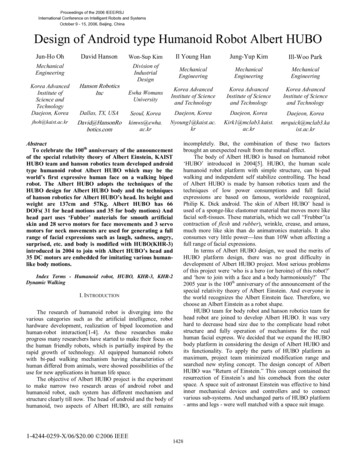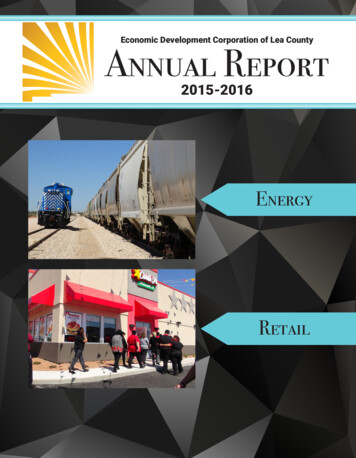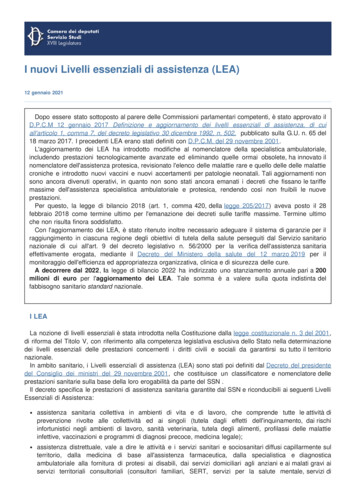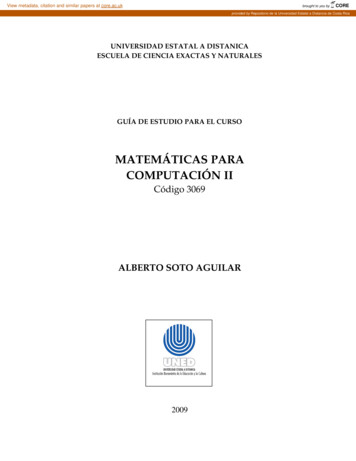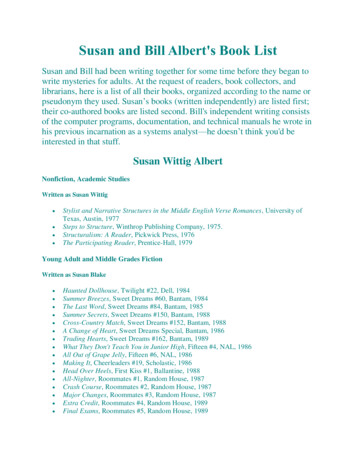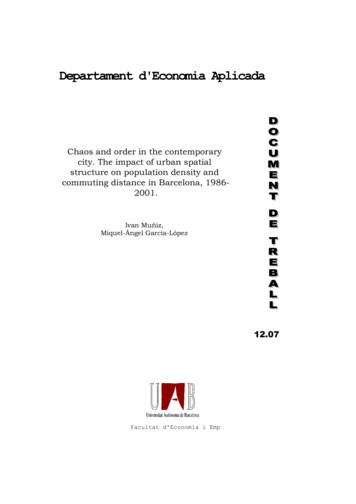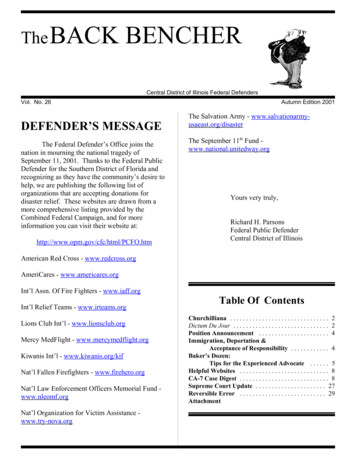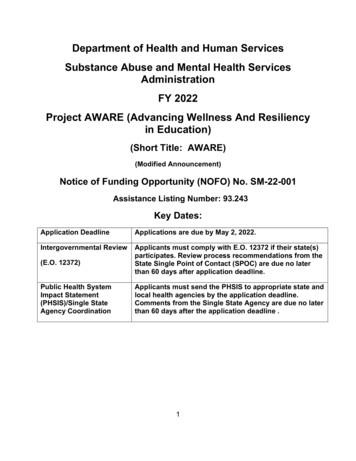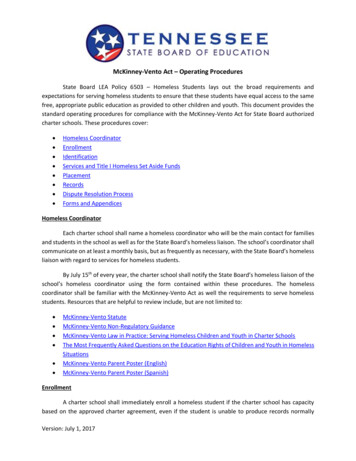![City Of Albert Lea O ] U } V W O V](/img/29/albert-lea-climate-action-plan-web.jpg)
Transcription
City of Albert Lea ůŝŵĂƚĞ ĐƟŽŶ WůĂŶJune 29, 2021Prepared by:
Table of ContentsdžĞĐƵƟǀĞ ƵŵŵĂƌLJAcknowledgementsdŽƉ ůŝŵĂƚĞ ĐƟŽŶƐ ĞĐƟŽŶ Ϭϭ /ŶƚƌŽĚƵĐƟŽŶ ĞĐƟŽŶ ϬϮ Buildings and Energy ĞĐƟŽŶ Ϭϯ dƌĂŶƐƉŽƌƚĂƟŽŶ ĂŶĚ ĂŶĚ hƐĞ ĞĐƟŽŶ Ϭϰ Waste Management ĞĐƟŽŶ Ϭϱ Water and Wastewater ĞĐƟŽŶ Ϭϲ Local Food and Agriculture ĞĐƟŽŶ Ϭϳ Greenspace and Trees ĞĐƟŽŶ Ϭϴ Health and Safety ĞĐƟŽŶ Ϭϵ Climate Economy ĞĐƟŽŶ ϭϬ ůŝŵĂƚĞ ĐƟŽŶ /ŵƉůĞŵĞŶƚĂƟŽŶ Appendix 1 Glossary of TermsAppendix 2 ƵƉƉŽƌƟŶŐ ZĞƐĞĂƌĐŚClimate Vulnerability Assessment ŽŵŵƵŶŝƚLJ tŝĚĞ ŽůĂƌ ŶĞƌŐLJ WŽƚĞŶƟĂůƐ ƚƵĚLJi
Our ChallengeThe complex systems that make up modern civiliza onresult in stressors on the delicate balance of our ecosystems. The combus on of fossil fuels is warmingearth’s atmosphere and changing our climate. Climatechange is already affec ng Albert Lea and its impactsare projected to become much more severe in thecoming decades. These impacts also contribute to addi onal strain on vulnerable popula ons, social sysIn 2017, Albert Lea achieved “Step 3” in the GreenStep tems, and overall community resilience.Ci es program. Minnesota GreenStep Ci es is a voluntary challenge, assistance and recogni on program to Our Opportunityhelp ci es achieve their sustainability and quality-ofThe impacts of ci es represent a major sustainablelife goals.development opportunity. Transforma on of our energy system is essen al in order to stop burning fossilIn 2017, the City of Albert Lea was selected by thefuels. This transi on presents an opportunity for AlState of Minnesota to receive technical assistance inbert Lea. Direc ng our energy investments into renewdeveloping a Climate Vulnerability Assessment. Theable sources will make them more resilient and proassessment was completed by paleBLUEdot in January vide for local job crea on. Innova on, technology, and2018. In 2019, supported through a second grant bycollec ve social change inherent in climate ac on canthe State of Minnesota, the City of Albert Lea engaged also support greater community abundance andpaleBLUEdot for the development of a Climate Ac on shared equity.Plan outlining strategies and ac ons to support achieving increased climate resilience as well as reduc ons inCity of Albert Lea City-Wide emissions. This reportplan is the result, developed in collabora on with theCity’s Climate Ac on Planning Team.The City has been dedicated sustainability issues formany years, and its focus on these topics has becomeincreasingly strong in recent years. In 2009, Albert Leabecame a pilot Blue Zone Project community. TheBlue Zone Project supports community transforma onprograms to increase sustainable healthy living community-wide.iiiAlbert Lea Climate Ac on Plan
Executive SummaryGHG Emission Reduction Goal in State ContextThe State of Minnesota has established state-widegreenhouse gas (GHG) reduction goals through 2050.Using a baseline year of 2005, the State’s goals are toreduce total emissions by 80% by 2050 with a benchmark reduction of 30% by 2025. Through 2018, statewide emissions have been reduced by 8%.Our Climate GoalsdŚŝƐ ůŝŵĂƚĞ ĐƟŽŶ WůĂŶ ŝŶĐůƵĚĞƐ Ă ůŝŵĂƚĞ ZĞƐŝůŝĞŶĐĞ sŝƐŝŽŶ ĂƐ ǁĞůů ĂƐ Ă ',' ƌĞĚƵĐƟŽŶ ŐŽĂů͘ dŚĞƐĞ ŐŽĂůƐ are designed to support and relate to the overall Stateof Minnesota goals and Įt with current science basedƌĞĐŽŵŵĞŶĚĂƟŽŶƐ͗Albert Lea Climate Resilience VisionTo become a climate resilient community,ŵĂŬŝŶŐ ƚŚĞ ƐŽĐŝĂů ĂŶĚ ĞĐŽŶŽŵŝĐ ƚƌĂŶƐŝƟŽŶƐ necessary to reduce city-wide greenhouse gasĞŵŝƐƐŝŽŶƐ ǁŚŝůĞ ƉƌŽƚĞĐƟŶŐ ůďĞƌƚ ĞĂ͛Ɛ ŶĂƚƵƌĂů ĞĐŽƐLJƐƚĞŵƐ͕ ŵŽƐƚ ǀƵůŶĞƌĂďůĞ ƉŽƉƵůĂƟŽŶƐ͕ ĂŶĚ economic vitality against the increasing impacts of climate change. ůďĞƌƚ ĞĂ ',' ZĞĚƵĐƟŽŶ 'ŽĂů The City of Albert Lea’s GHG emission reducƟŽŶ ŐŽĂůƐ ĂƌĞ ƚŽ ďĞ ĐŽŵƉĂƟďůĞ ǁŝƚŚ ƚŚĞ ƚĂƚĞ of Minnesota GHG Emissions goals and shallƚĂƌŐĞƚ Ă ƌĞĚƵĐƟŽŶ ŝŶ ŝƚLJ ŽƉĞƌĂƟŽŶƐ ĂŶĚ ĐŽŵͲmunity-wide emissions of 25% below 2019 levels by 2030 and 80% below 2019 levels by2040.Albert Lea’s Carbon Reduction Pathway2019306,679Projected City-wide GHG reductions from CAP implementationMetric Tons2019 GHG by SectorCity-wide Emissions17%2%81%Avoided GHG emissionsthrough implementation ofthis plan2030230,331Metric Tons ůďĞƌƚ ĞĂ ůŝŵĂƚĞ ĐƟŽŶ WůĂŶiv
Climate AcƟon Plan as Living PlanThis Climate Ac on Plan is intended as a “living plan”rather than a sta c document. This means that theimplementa on phase of this plan should be characterized by intermi ent measurement of progress andplan adjustments. Plan adjustments should look towards increasing implementa on goals for ac onswhich illustrate success, modify goals for ac onswhich may fall short of desired outcomes, and iden fying addi onal ac on opportuni es.As a “living plan,” the 2030 emission reduc on goalshould be seen as a guiding constant and recogni onshould be given that ini al implementa on ac onsmay not yet fully achieve plan goals. Intermi ent planprogress measurements and adjustments should idenfy addi onal ac ons, or increases in ac on implementa on targets as needed to meet the ul mate2030 GHG reduc on goal.vNext Steps and ImplementaƟonThis Albert Lea Climate Ac on Plan is only the beginning of an on-going process of evalua ng and advancing the City’s climate resilience, GHG emissions reducons, and overall sustainability. The plan includes aClimate Ac on Implementa on sec on providing aframework for launching, guiding, monitoring, andevalua ng the execu on of this plan. The implementa on sec on outlines specific next steps, and important implementa on considera ons and recommenda ons. As details and outcomes are uncoveredduring the implementa on phase, adjustments toquan ta ve goals, milestones, and detailed ac onswill be made responsively.Albert Lea Climate Ac on Plan
AcknowledgementstĞ ĂƌĞ ĚĞĞƉůLJ ŐƌĂƚĞĨƵů ĨŽƌ ƚŚĞ ĐŽŵŵƵŶŝƚLJ ĐŽůůĂďŽƌĂƟŽŶ ĂŶĚ ŝŶƉƵƚ ƚŚĂƚ ǁĞŶƚ ŝŶƚŽ ƚŚŝƐ ƉůĂŶ͘ ĞůŽǁ ĂƌĞ ƐŽŵĞ ŽĨ ƚŚĞ ŵĂŝŶ contributors that made Albert Lea’s Įrst CAP possible:City of Albert Lea Project LeadDalton Syverson City of Albert Lea EnvironmentalEngineerMayorVern RasmussenCity Council MembersRich Murray, 1st WardLarry Baker, 2nd WardJason Howland, 3rd WardReid Olson, 4th WardRobert Rasmussen, 5th WardAl “Minnow” Brooks, 6th Ward ŽŵŵƵŶŝƚLJ ůŝŵĂƚĞ ĐƟŽŶ WůĂŶŶŝŶŐ dĞĂŵJD CarlsonCity of Albert LeaTom JensenFreeborn CountyMark GoskesonFreeborn CountyPhilip JohnsonALEDAJoe GrossmanCity of Albert LeaJosh KarausPOET BioreĮninigRich HallFreeborn CountyLinda LaresSEMCACAndy HenshelIan RiggCity of Albert LeaBryan SkogheimFreeborn Mower Electric CoopƌŝĐ ,ƵŶŶŝĐƵƩShell Rock River WatershedDistrict (SRRWD)Senior Resources of FreebornCountyREGDalton SyversonCity of Albert LeaBrandon HustonCity of Albert LeaJen Vogt-Erickson Resident of Albert LeaSteven JahnkeCity of Albert LeaRachel WehnerJackie HillmanFreeborn CountyConsultant TeamFundingWĂƌƟĂů ĨƵŶĚŝŶŐ ĨŽƌ ƚŚŝƐ ƉƌŽũĞĐƚ ǁĂƐ ƉƌŽǀŝĚĞĚ ƚŚƌŽƵŐŚ Ă ϮϬϭϴ ƚĂƚĞ ŽĨ DŝŶŶĞƐŽƚĂ WŽůůƵƟŽŶ ŽŶƚƌŽů ŐĞŶĐLJ ;DW Ϳ ŶǀŝƌŽŶŵĞŶƚĂů ƐƐŝƐƚĂŶĐĞ 'ƌĂŶƚ ƐƵƉƉŽƌƟŶŐ ƚŚĞ ĐůŝŵĂƚĞ ĂĚĂƉƚĂƟŽŶ ƉůĂŶŶŝŶŐ ƉŽƌƟŽŶ ŽĨ ƚŚŝƐ ƉůĂŶ͘Climate PlanningTed RedmondColleen RedmondAlliance for SustainabilityCommunity EngagementConsultantSean Gosiewski ůďĞƌƚ ĞĂ ůŝŵĂƚĞ ĐƟŽŶ WůĂŶvi
Top Climate ActionsThe following are likely the most impactful 15 actions and initiatives included in the Climate Action Plan. These actions represent a “Quick Start” sub-list of highly impactful actions for community-wide and municipal operations climate action. These actions are recommended for prioritized implementation over the next 1 to 3 years:Community-Wide Quick Start Climate ActionsStrategy BE-5: Increase on-site distributed reStrategy BE-1: Improve total Community widenewable energy to 5% of ZesidenƟal and ComreƐidenƟal͕ ĐommerĐial͕ and induƐtrial ďuildingmercial electric use by 2030.energy eĸciency by 8% Electricity and 8% Thermal Fuel by 2030.BE-5-1 Establish a policy which requires all new construcBE-1-1 tork with &reeborn Mower CooperaƟve Services,Ɵon and signiĮcant renovaƟon proũects for CityMinnesota Energy Resources, and other partnersfaciliƟes to be constructed to meet "Solar Ready"Ʃo establish commercial energy eĸciency auditrequirements and to include a solar feasibility asand upgrade program similar Minnesota Chambersessment and proũect opƟon for inclusion of onof Commerce’s EnergySmart commercial energysite solar, include "Return on Investment" assesssavings program. Program could be integratedment, and incorporate solar where return is favorwith the commercial waste audit service idenƟĮedable.in Solid taste acƟon tM-1-1. Target: 24 commer- BE-5-3 Coordinate and promote a commercial Solar Groupcial/industrial businesses per year with 10% elecPurchase Campaign annually to help reduce thetricity savings and 10% natural gas savings each.costs of solar installaƟon through volume /ing power (goal, 600KW installed annually). Groupenergy-smart )purchase campaign could include/focus on properBE-1-3 tork with &reeborn Mower CooperaƟve Services,Ɵes idenƟĮed in the "Solar Top 30" assessmenteīort. Program design to explore strategies toMinnesota Energy Resources, and other partnersto establish residenƟal and mulƟ-family energysupport local small business solar installers andeĸciency audit and upgrade program similar tostrategies to support local workforce developmentXcel Energy's "Home Energy Squad Visits". Targetin coordinaƟon with Riverland Community College.120 households per year (hƩps://Strategy TL-1: Decrease community wide VMT bywww.homeenergysquad.net/)5% by 2030.Strategy BE-ϰ: chieve ϳ% reƐidenƟal and ϳ%commercial and industrial building thermal "fuelswitching" to reduce on-site fossil fuel use by2030.BE 4-1 Promote incenƟve programs for electriĮcaƟon.Work with Freeborn Mower or other regional partnerships to create Įnancial incenƟves to electrifynew and edžisƟng buildings. For edžample, rebatesfor panel upgrades, electric appliances, Air SourceHeat Pumps, and Ground Source Heat Pumps canencourage the transiƟon to electric energy use inhomes and businesses. Goal: Target 10% residenƟal market conversion (ϳ5 households annually)and 5% commercial/industrial market conversion(an esƟmated 10 commercial businesses, 10 industrial businesses annually) by 2030. Resource:hƩps://fmec.coop/rebatesviiTL-1-2 Conduct a Complete Streets Status and QualityAssessment to provide a comprehensive review ofthe coverage, quality, and opportuniƟes of complete streets in the community. Study to idenƟfyneeds to accelerate bike paths, building sidewalks,crosswalks, and other walking infrastructure, parƟcularly in high-need areas and areas serving vulnerable populaƟons. Create an implementaƟonplan establishing annual increases in the total milesof sidewalks, on-road bicycle lanes and mulƟ-usepaths.Strategy TL-3: Increase baƩery electric vehicle;BEVͿ uƟlinjaƟon to 20% of community wide rollingstock (from approximately 3,200 vehicles community-wide).TL-3-1 Create a citywide EV Roadmap. Plan should createcitywide and city facility electric vehicle (EV) charging staƟon study and masterplan to map exisƟnginfrastructure, determine the current and futuredemand for EV charging staƟons, Establish publicEV parking regulaƟon, and to idenƟfy opƟons forincreasing number of electric charging staƟons inpublic parking areas and in commercial and highdensity residenƟal areas. Plan should include implementaƟon strategies to meet citywide EV charging demand and promote adopƟon of EVs withingthe community.Albert Lea Climate AcƟon Wlan
Top Climate ActionsCity Operations Quick Start Climate ActionsStrategy BE-1: Improve total Community wideresidenƟal, commercial, and industrial buildingenergy eĸciency by 8% Electricity and 8% Thermal Fuel by 2030.BE-1-2 Conduct a City FaciliƟes Energy Audit on all buildings within the next 3 years. Use results from CityFaciliƟes Energy Audit to prioriƟnje City FaciliƟesCapital Improvement Plans (CIPS) and maintenanceimprovements. Goal: Reduce City of Albert Leafacility energy consumpƟon by 10%.BE-1-4 Convert all City streetlights and signals to LED by2030.Strategy BE-3: chieve 10 EEEZ'z ST Z cerƟĮednew or renovated commercial buildings withinthe community by 2030.BE-3-1 Establish a policy to require all primary City faciliƟes to benchmark (using EEERGz STAR PorƞolioManager or B3 Benchmarking) and disclose annualenergy consumpƟon. Invite County, School District, and other public agencies located within theCity to parƟcipate in City's faciliƟes benchmarkingand disclosure eīort.Strategy BE-ϰ: chieve ϳ% residenƟal and ϳ%commercial and industrial building thermal "fuelswitching" to reduce on-site fossil fuel use by2030.BE 4-2 Work with regional energy partnerships to developand implement an ElectriĮcaƟon AcƟon Plan for allCity faciliƟes. Include new and exisƟng buildings,incorporate strategies to address electricity storage, and focus on highlighƟng any hurdles or soluƟons that would be applicable to the broader communityStrategy TL-3: Increase baƩery electric vehicle(BEV) uƟlinjaƟon to 20% of community wide rollingstock (approximately 3,200 vehicles communitywide).TL-3-2 Conduct a Fleet and Equipment Use and OperaƟons Assessment to analynje city Ňeet and equipment use and to provide a guide for the right vehicle/equipment for City funcƟons, with a focus onadvancing EV and high fuel eĸciency features (likeauto-oī). Assessment to idenƟfy most economicalways of operaƟng which miniminje emissions andfuel consumpƟon (i.e. mowing paƩerns and schedules, street plowing eĸciency study, policy patroleĸciency study, etc)TL-3-3 Update City vehicle purchasing policy/budget process to default to EV and non-fossil fuel alternaƟves with tradiƟonal internal combusƟon engine(ICE) as opƟonal requiring proof of need. For ICEvehicle opƟons, establish minimum fuel eĸciencyrequirements. Focus on small vehicles as well aslarge vehicles for alternaƟve fuels. EV replacementto be prioriƟnjed for high mileage vehicles. Goal:Achieve 50% EVs within City Fleet by 2030.Strategy W-3: MiƟgate the proũected increasedŇood hazards and impacts due to climate change.W-3-1 Establish a Storm Water InĮltraƟon Plan idenƟfyingpriority areas and strategies for improved inĮltraƟon of storm water to miniminje storm water volumes requiring handling while increasing wateraquifer recharging. Strategies to focus on reducƟon of impervious surfaces, increase of permeablesurfaces, trees, bio swales, rain barrels, rain gardens, compost, mulch, etc. Coordinate and integrate Plan with city's Citywide Heat Island ImpactStudy (see Buildings and Energy acƟons)Strategy CE-4: Establish sustainable Įnancing forthe City͛s climate acƟon implementaƟon.CE-4-1 Establish a policy that savings generated by energyeĸciency measures and renewable energy installaƟons/agreements for City faciliƟes and operaƟonsshall be used as a fund to support future energyeĸciency and renewable energy projects in support of the CAP goals.Albert Lea Climate AcƟon Planviii
Click here toreturn to TOC
Albert Lea, Minnesota, a City of 17,770 people, is located on the crossroads of interstates 35 and 90. Thecity benefits from a diverse economic base, rangingfrom health care, educa on, manufacturing (primarilyfood related), and financial, to unique design and bouque-type businesses. Its natural beauty, seven lakesand bays, offer a unique environment for its residentsand visitors.Albert Lea’s major assets are its lakes. In the center oftown is Fountain Lake. This is a recrea onal lake,known for boa ng, fishing, water skiing, and paddleboarding. It also has a walking path around its perimeter. In the city and connected by a channel to Fountain Lake is Albert Lea Lake. This large natural lake isprimarily used for canoeing, kayaking, and fishing. It isbordered by Myre Big Island State Park which featuresa natural oak savanna landscape. This State Park isknown for its wildlife with 234 different kinds of birds.Why Create a Climate AcƟon PlanThe crea on and dedicated implementa on of a Climate Ac on Plan (CAP) is an organized way for a Cityto contribute to solving the global climate crisis whilehelping its resident and business communi es createimproved resilience to the current and future impactsand risks of climate change. Climate ac on can alsocreate investment in innova on, jobs and ac ons thatsave households and businesses money.What is a Climate AcƟon Plan (CAP)Climate ac on plans are comprehensive road mapsthat outline the specific Strategies and Ac ons that aCity will implement to reduce greenhouse gas emissions and build resilience to related clima c impacts.The Albert Lea CAP addresses both climate mi ga onand climate adapta on ac ons.The Role of CommuniƟes in Climate AcƟonWith a large majority of Americans living in urban areas, communi es play a key role in addressing climateThe City has been dedicated sustainability issues forchange. While each individual community’s impact onmany years, and its focus on these topics has become global GHG emissions is rela vely small, the leadershipincreasingly strong in recent years. In 2017, Albert Lea municipali es provide in mo va ng change can beachieved “Step 3” in the GreenStep Ci es program.extremely significant. According to a survey by the USMinnesota GreenStep Ci es is a voluntary challenge,Conference of Mayors, more than half (53%) had comassistance and recogni on program to help ci esmi ed to reducing greenhouse gas emissions.achieve their sustainability and quality-of-life goals.Building on Past WorkIn 2017, the City of Albert Lea was selected by theThis Climate Ac on Plan builds on past projects andState of Minnesota to receive technical assistance inplanning efforts of the City of Albert Lea, including thedeveloping a Climate Vulnerability Assessment. TheCity’s Climate Vulnerability Assessment and Renewaassessment was completed by paleBLUEdot in January ble Energy Poten als Study2018. In 2019, supported through a second grant bythe State of Minnesota, the City of Albert Lea engagedpaleBLUEdot for the development of a Climate Ac onPlan outlining strategies and ac ons to support achieving increased climate resilience as well as reduc ons inCity of Albert Lea City-Wide emissions. This reportplan is the result, developed in collabora on with theCity’s Climate Ac on Planning Team.1-3Albert Lea Climate Ac on Plan
Climate AcƟon as a JourneyThe Climate Ac on Plan represents a robust vision ofthe future with a comprehensive scope of ac ons befi ng the magnitude of our collec ve climate challenge ahead. This Climate Ac on Plan establishes along-term climate resilience vision and mi ga on goalfor the community. The plan itself, its strategies, anddetailed ac ons, are intended as a 9 year plan. It isan cipated that this plan would be updated by 2030 tooutline the next phase of ac on towards achieving thelong-term community-wide goals.The Albert Lea Climate Ac on Plan should be seen as aliving document. Ac on progress and effec venessshould be reviewed at regular intervals through theplan’s implementa on and adjustments should bemade to expand or modify the scope of individual acons and to augment the plan with new ac ons as appropriate to respond to ever-changing market andcommunity condi ons.Benefits of Climate AcƟonThe strategies and ac ons contained in this plan seekto reduce Albert Lea’s dependence on fossil fuels, priori ze sustainable uses of land and water, reducewaste, and support improved equity and livability.The ac ons outlined in this plan will reduce AlbertLea’s GHG emissions. In addi on to reducing the community’s contribu on to climate change this planstrives to iden fy how climate change will increasinglyimpact the community. The Climate Ac on Plan addresses next steps for Albert Lea to adequately respond to climate change. If implemented successfullythe plan will enhance Albert Lea’s economic vitality,resilience, and viability as a healthy, livable community.Albert Lea Climate Ac on Plan1-4
Albert Lea’s Vulnerability to Climate Risks:Climate change is a global phenomenon that creates local impacts. It presents one of the most profound challenges of our me. A broad interna onal consensus exists among atmospheric scien sts that the Earth’s climate system is being destabilized in response to elevated levels of greenhouse gas emissions in the atmosphere.Two changes to Minnesota’s climate are occurring already: shorter winters with fewer cold extremes, andmore heavy and extreme precipita on. Increases in the global surface temperature and changes in precipitaon levels and pa erns are expected to con nue and intensify for decades. In turn, these changes in climatehave impacts on the economy and health of local communi es.The following highlight the vulnerabili es to climate risks facing Albert Lea, excerpted from the 2018 Albert LeaClimate Vulnerability Assessment:Heat Stress(High)Air QualityVector-Borne DiseaseMental Health(High)(Medium—Low)(Medium)Warmer temperaturesand more extreme heatmay lead to higher risk ofheat-related illness.Increased heat may resultin more days of poor airquality and exposure toallergens, impac ngrespiratory illnesses.Longer growing seasonsand higher temperaturesmay increase vectorborne diseases like WestNile Virus and Lymedisease.Exposure to increasedclimate impacts and disasters may lead to increased anxiety andother mental healthramifica ons.HousingStormwaterManagementTrees, Greenspace,and AgricultureSurface WaterQuality(High)(High)(Medium)(Low)Warmer temperatures willincrease demand for aircondi oning and weatheriza on needs. Energy costsmay be difficult for vulnerable popula ons to meet.Heavier rains coupled withhigher risk of surfacedrought condi ons maycause more local flooding,par cularly “flash flooding”which could cause damageto housing and reduce mobility for por ons of thecommunity.Heavier rains coupled withhigher risk of surfacedrought condi ons maysignificantly increase demand on stormwater management. The City’s stormwater infrastructure maynot be capable of handlingthe amount of runoff duringmore frequent heavy downpours, requiring resourcesto make needed upgrades.Increased temperatures andchanges to precipita on willstress trees, greenspace,and agriculture. Condi onsmay be more favorable fordisease, pests, and invasivespecies. Trees and crop species which formerly thrivedin the area’s climate may beless suited for futureclimate condi ons.Increases to heavy rainevents and flooding/flashflooding risk may nega velyimpact water quality in theCity’s lakes, streams, andrivers. Increased pollutantsand contamina on potenal, combined with increased annual water temperatures could increaserisk to algal and bacterialgrowth, harming habitatsand limi ng recrea on.1-5Albert Lea Climate Ac on Plan
What Are GHG’s?A greenhouse gas is a molecule inthe atmosphere which does notreact to light energy in the visiblerange (like sunlight), but does reactto light energy in the infrared range-like that which is emi ed from theEarth a er being warmed by thesun. The most common greenhousegases include carbon dioxide (CO2),methane (CH4), and nitrous oxide(N2O).Why do GHG’s MaƩer?GHG’s let the sun's light shine ontothe Earth's surface, but they trapthe heat that reflects back up intothe atmosphere. In this way, theyact like the insula ng glass walls ofa greenhouse. The more GHGsthere are, the more heat that istrapped in our atmosphere and themore we experience the impacts ofglobal warming.City of Albert Lea GHG EmissionsThe City of Albert Lea’s communitywide emissions for 2019 totaled306,679 metric tons. Of that,249,542 metric tons were from thebuildings and energy sector, 52,415metric tons were from the transporta on sector, 4,201 metric tonswere generated from solid waste,and 520 metric tons came from water and wastewater genera on.2%Key Greenhouse Gas SectorsWhere do City wide GHGs come from?17%81%2019CitywideEmissions:306,679Metric TonsEnergyEmissions are produced from the combus on of natural gas,coal, and other fossilfuels primarily forhea ng, cooling, andelectricity genera on.TransportaƟonEmissions come fromthe combus on offossil fuels for groundtransporta on and airtravel.Solid WasteEmissions in the inventoryes mate the decomposion of biodegradablewaste (e.g., food and yardwaste) in the landfill.Albert Lea Climate Ac on PlanWater WastewaterEmissions from energyuses are calculated fortreatment and distribuon of water and thecollec on and treatmentof wastewater.1-6
IntroductionGHG Emission Reduction Goal in State ContextThe State of Minnesota has established state-wide greenhouse gas (GHG) reduction goals through 2050. Usinga baseline year of 2005, the State’s goals are to reduce total emissions by 80% by 2050 with a benchmark reduction of 30% by 2025. Through 2018, state-wide emissions have been reduced by 8%Our Climate GoalsdŚŝƐ ůŝŵĂƚĞ ĐƟŽŶ WůĂŶ ŝŶĐůƵĚĞƐ Ă ůŝŵĂƚĞ ZĞƐŝůŝĞŶĐĞ sŝƐŝŽŶ ĂƐ ǁĞůů ĂƐ Ă ',' ƌĞĚƵĐƟŽŶ ŐŽĂů͘ dŚĞƐĞ ŐŽĂůƐ ĂƌĞ designed to support and relate to the overall State of Minnesota goals and Įt with current science based recŽŵŵĞŶĚĂƟŽŶƐ͗Albert Lea Climate Resilience VisiondŽ ďĞĐŽŵĞ Ă ĐůŝŵĂƚĞ ƌĞƐŝůŝĞŶƚ ĐŽŵŵƵŶŝƚLJ͕ ŵĂŬŝŶŐ ƚŚĞ ƐŽĐŝĂů ĂŶĚ ĞĐŽŶŽŵŝĐ ƚƌĂŶƐŝƟŽŶƐ ŶĞĐĞƐƐĂƌLJ ƚŽ ƌĞͲduce city-ǁŝĚĞ ŐƌĞĞŶŚŽƵƐĞ ŐĂƐ ĞŵŝƐƐŝŽŶƐ ǁŚŝůĞ ƉƌŽƚĞĐƟŶŐ ůďĞƌƚ ĞĂ͛Ɛ ŶĂƚƵƌĂů ĞĐŽƐLJƐƚĞŵƐ͕ ŵŽƐƚ ǀƵůͲŶĞƌĂďůĞ ƉŽƉƵůĂƟŽŶƐ͕ ĂŶĚ ĞĐŽŶŽŵŝĐ ǀŝƚĂůŝƚLJ ĂŐĂŝŶƐƚ ƚŚĞ ŝŶĐƌĞĂƐŝŶŐ ŝŵƉĂĐƚƐ ŽĨ ĐůŝŵĂƚĞ ĐŚĂŶŐĞ͘ ůďĞƌƚ ĞĂ ',' ZĞĚƵĐƟŽŶ 'ŽĂů dŚĞ ŝƚLJ ŽĨ ůďĞƌƚ ĞĂ͛Ɛ ',' ĞŵŝƐƐŝŽŶ ƌĞĚƵĐƟŽŶ ŐŽĂůƐ ĂƌĞ ƚŽ ďĞ ĐŽŵƉĂƟďůĞ ǁŝƚŚ ƚŚĞ ƚĂƚĞ ŽĨ DŝŶŶĞƐŽƚĂ ',' ŵŝƐƐŝŽŶƐ ŐŽĂůƐ ĂŶĚ ƐŚĂůů ƚĂƌŐĞƚ Ă ƌĞĚƵĐƟŽŶ ŝŶ ŝƚLJ ŽƉĞƌĂƟŽŶƐ ĂŶĚ ĐŽŵŵƵŶŝƚLJ-wide emissions of25% below 2019 levels by 2030 and 80% below 2019 levels by 2050.1-7 ůďĞƌƚ ĞĂ ůŝŵĂƚĞ ĐƟŽŶ WůĂŶ
EsƟmated City Wide GHG ReducƟons Included in This PlanLong-term emission reduc on poten als of the strategies and ac ons included in this plan have been modeledbased on projected energy and fuel reduc ons and adop on rates of renewable energy and low/no emissiontransporta on modes outlined in the strategies and ac ons. From this modeling, we know that with the successful implementa on of this climate ac on plan, by 2030 City wide annual GHG emissions are projected to be76,348 metric tons below 2019 levels. The poten al cumula ve GHG emissions reduc ons over the 9 year implementa on period are es mated at over 350,000 metric tons - an elimina on of over 6.9 billion cubic feetof man made greenhouse gas atmosphere resul ng from this climate ac on plan.Albert Lea Climate Ac on Plan1-8
The ProcessThe plan was developed in collabora on with an 18person planning team of community members, business community members, non-profit organiza ons,Freeborn County, and City of Albert Lea staff. The planning team was organized into sub-teams aligned witheach of the community-wide climate ac on sectorsincluded in this plan (see Plan Framework). The planwas developed through a number of planning workshops from January 2021 through May 2021.Development and implementa on of the Albert LeaClimate Ac on Plan are opportuni es for the City ofAlbert Lea government and partners in the communityto research and ar culate some of Albert Lea’s mostpressing resilience challenges; iden fy specific, mul benefit ac ons that contribute to solu ons to thosechallenges; and secure addi onal resources, technicalassistance, and partnerships to accelerate next steps.The goals and ac ons iden fied in the Climate Ac onPlan are grounded in community input, expert analysis, and best prac ces from other ci es throughout theUnited States. Strategic goals and detailed ac onswere developed by the Planning Team through a seriesof workshop mee ngs. A preliminary dra of ac onswere reviewed against ac on screening criteria whichenabled the Planning Team to evaluate, refine, finalize,and priori ze the ac ons to be incorporated in thefinal Climate Ac on Plan.Albert Lea AcƟon Screening CriteriaSupport: How likely is the proposal to be adopted bythe City or community-wide? Is it poli cally feasible? Isthere community support? If funding is needed can/will it be made available?PotenƟal for Success: Do these strategies have a trackrecord for success locally or in other communi es?Co-Benefits: Does the ac on address mul ple goals, orother City or community objec ves ? Does the strategy address needs in resilience, public health/quality oflife, economic prosperity, triple bo om line, stewardship, and/or innova on?Climate AcƟon Plan FrameworkThis Climate Ac on Plan includes an implementa on framework designed to achieve community-wide goals for greenhouse gas reduc onand climate adapta on and resilience. The planis organized around a unifying framework organized by sector as illustrated to on the followingpage. Each sector has over-arching Strategiesestablished to meet 2030 goals and detailedAc ons for implementa on. Sector ac ons include a focus on Climate Mi ga on, ClimateAdapta on, or both.Climate MiƟgaƟon: addresses the root causesof climate change through the reduc on or preven on of greenhouse gas (GHG) emissions.Sectors with this as a significant focus areshown to the right with this symbol:Climate AdaptaƟon: seeks to lower the risksposed by the impacts of climate change whichare now inevitable or likely. Sectors with this asa significant focus are shown to the right withthis symbol:1-9Albert Lea Climate Ac on Plan
Climate AcƟon Plan FrameworkBuildings and EnergyTransportaƟon and LandUseEmissions associated with all electricityand natural gas consump on within the Emissions from on-road vehicle trafficCity. Approaches to this sector areaoccurring in the community. Approachinclude improved energy efficiency and es to this sector area include reducresilience.ons in vehicle miles traveled as well asshi s to public transit and alterna veWaste ManagementAll solid waste generated by residentsand businesses within the communityand their associated emissions. Approaches in this sector focus on diversion of food, consumer, and construcon waste.Greenspace and TreesResilience of urban tree canopy,ground cover, greenspace, parks, andecosystems. Foc
energy e 8ciency by 8% Electricity and 8% Ther-mal Fuel by 2030. BE-1-1 tork with &reeborn Mower Coopera ve Services, Minnesota Energy Resources, and other partners o establish commercial energy e 8ciency audit and upgrade program similar Minnesota Chamber of Commerce's EnergySmart commercial energy savings program. Program could be integrated
